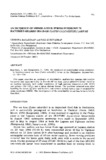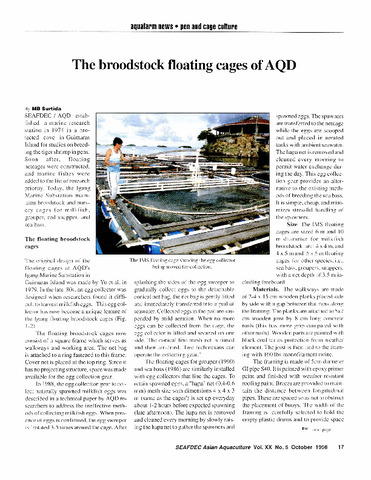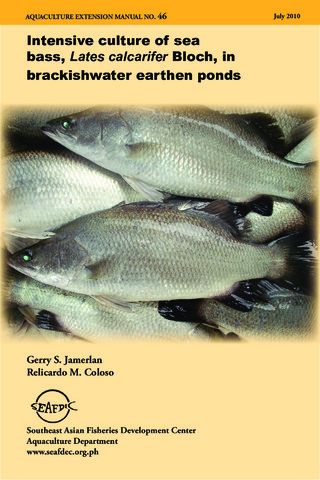An incidence of swimbladder stress syndrome in hatchery-reared sea bass (Lates calcarifer) larvae
- Global styles
- MLA
- Vancouver
- Elsevier - Harvard
- APA
- Help

View/
Date
1986Page views
2,145ASFA keyword
AGROVOC keyword
Taxonomic term
Metadata
Show full item recordCited times in Scopus
Share
Abstract
This paper describes an incidence of swimbladder malfunction causing high positive buoyancy and mass mortality in 2-week-old sea bass (Lates calcarifer) larvae reared in an outdoor hatchery tank under conditions of high ambient temperature (26–32°C) and salinity (32–34‰), and a dense diatom bloom. The problem occurred soon after handling the larvae by seine and bucket, and seemed to have been a case of swimbladder stress syndrome (SBSS). The development of the swimbladder in sea bass larvae is briefly described.
Description
Contribution No. 166 from the SEAFDEC Aquaculture Department.
Suggested Citation
Bagarinao, T., & Kungvankij, P. (1986). An incidence of swimbladder stress syndrome in hatchery-reared sea bass (Lates calcarifer) larvae. Aquaculture , 51(3-4), 181-188. https://doi.org/10.1016/0044-8486(86)90308-X
Type
ArticleISSN
0044-8486Collections
- Journal Articles [1229]
Related items
Showing items related by title, author, creator and subject.
-
The broodstock floating cages of AQD
Surtida, Marilyn B. (Aquaculture Department, Southeast Asian Fisheries Development Center, 1998) -
Sea bass, groupers and snappers
Duray, Marietta N. (Aquaculture Department, Southeast Asian Fisheries Development Center, 1994)Studies on sea bass (Lates calcarifer) broodstock were directed at techniques to maximize egg production. Now known are the: optimum luteinizing hormone releasing hormone analogue (LHRHa) dose range to induce spawning, ... -
Series: Aquaculture extension manual; No. 46
Intensive culture of sea bass, Lates calcarifer Bloch, in brackishwater earthen ponds
Jamerlan, Gerry S.; Coloso, Relicardo M. (Aquaculture Department, Southeast Asian Fisheries Development Center, 2010)An extension manual describing criteria for site selection, monoculture and polyculture operations including feeds and feeding, harvest, common diseases, economic analysis.






